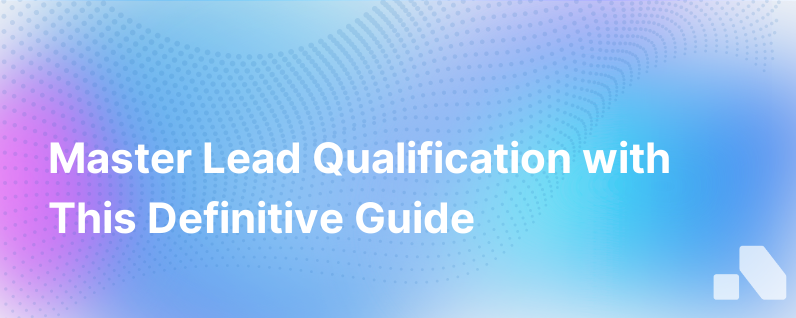
In the realm of sales, the significance of lead qualification cannot be overstated. It is a critical step in the sales process that can either streamline a path toward closing a deal or result in an inadvertent wild-goose chase. For businesses, particularly B2B sales, a rigorous lead qualification process ensures that sales efforts are not misspent on prospects with a low probability of conversion.
Let’s embark on an in-depth exploration of lead qualification and how it can be executed to near perfection.
Understanding Lead Qualification
At its core, lead qualification is the process of determining whether a prospective customer meets the criteria to become a paying customer. This involves a careful assessment of their fit with your product or service, their potential to purchase, and their position in the buying cycle.
The objective of lead qualification is two-fold:
- Efficiency: By filtering out less promising leads, sales representatives can devote more time and resources to nurturing those with a higher likelihood of conversion.
- Effectiveness: Qualified leads have a greater chance of advancing through the sales pipeline, leading to higher conversion rates and a better return on investment.
Establishing Lead Qualification Criteria
Before one can effectively qualify a lead, clear criteria should be set. These typically center on firmographics, budget, authority, needs, and timeline — often encapsulated in the BANT methodology (Budget, Authority, Need, and Timeline). Some businesses may also incorporate additional factors, such as the lead's technical compatibility and current solutions.
Firmographics
Understanding the lead's industry, company size, location, revenue, and market position helps assess whether they fit the ideal customer profile.
Budget
Determining whether the lead has the financial resources and willingness to allocate the necessary budget for your solution is crucial.
Authority
Identifying whether the lead has the decision-making power or is an influencer in the purchasing process is necessary to promote efficiency in the sales cycle.
Need
Assessing whether there is a genuine need for your product or service aligns the value proposition with the lead’s challenges and objectives.
Timeline
Establishing the lead’s buying timeline helps forecast the pipeline and prioritize sales efforts accordingly.
Using these parameters, sales representatives can develop a qualification scorecard to systematically evaluate each lead.
The Lead Qualification Process
A thorough lead qualification process involves several key steps from initial contact to final qualification.
Initial Contact
The first touchpoint with a lead should be leveraged to gather preliminary information. This can be facilitated through discovery calls, emails, or engagement analytics.
Discovery
During discovery calls or meetings, reps can delve deeper into understanding the prospect's business needs, challenges, and how your product fits into their current workflow or objectives.
Evaluation
Using lead scoring models, reps can evaluate the information against established criteria to gauge the lead's readiness and fit.
Qualification
With enough data, the lead is then placed into categories:
- SQL (Sales Qualified Lead): A lead that has been vetted by the sales team and is ready to enter the sales process.
- MQL (Marketing Qualified Lead): A lead that has shown interest and engaged with marketing efforts but may not yet be ready for direct sales engagement.
- Unqualified: A lead the does not currently meet the criteria for further pursuit.
Feedback Loop
Information from qualified and disqualified leads should feed back into marketing and product strategies to refine and improve targeting and lead generation.
Best Practices for Effective Lead Qualification
Implementing best practices in the lead qualification process is key to its success. Here are some strategies for perfecting your lead qualification efforts:
Automate Where Possible
Use CRM and marketing automation tools to track and score leads based on engagement, behaviors, and provided data. This helps in creating a more objective and scalable process.
Prioritize and Personalize Engagement
Understand that not all qualified leads require the same level of engagement. Segment your leads further to tailor your sales approach.
Training and Communication
Ensure your sales team is appropriately trained on qualification criteria and maintains regular communication with marketing to update and refine the qualifying factors.
Use Qualification Frameworks
Frameworks like BANT, CHAMP (Challenges, Authority, Money, Prioritization), or MEDDIC (Metrics, Economic buyer, Decision criteria, Decision process, Identify pain, Champion) can structure your qualification process.
Monitor and Iterate
Continuously monitor the outcomes of qualified leads and iterate the process as needed to accommodate changes in the market, product, or business strategy.
Leverage Insights and Technologies
Aomni, or similar AI platforms, can be harnessed to augment your lead qualification process with real-time insights into account research and competitive intelligence.
Closing Remarks
Lead qualification is not just a sales step; it's a profound alignment of a prospect’s potential and your business’s solutions, orchestrated to ensure mutual benefits. Perfecting this facet of your sales mechanism can take resilience and innovation, but the rewards are worth the endeavor. Excelling in lead qualification means engaging the right people, at the right time, with the right solution, ultimately charting a more predictable, profitable course for business growth. And while Aomni is just one of the myriad tools available for optimizing this process, its potential impact on your qualification process could be substantial, leaving more time for personal touchpoints that make all the difference.